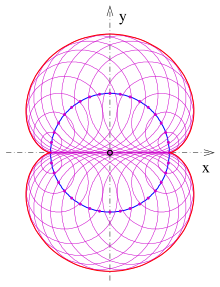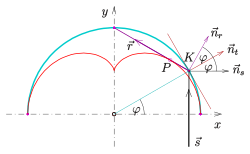Construction of a nephroid by rolling a circle on a circle with a double radius
Construction of the same nephroids by rolling a circle around a half-radius circle
A nephroid (from ancient Greek ὁ νεφρός ho nephros , "the kidney", according to its shape) is an algebraic curve of the 6th degree. The nephroids are created by rolling a circle with the radius on the outside of a circle with the radius . The nephroids thus belong to the epicycloid class .


Equations of a nephroid
If the radius of the small (rolling) circle and the center and radius of the large (fixed) circle, the roll angle (of the small circle) and the point are the starting point (see picture), then you get the




- Parameter representation:

-
 .
.
Substituting the parametric representation into the equation

proves that it is the corresponding implicit representation.
- Proof of the parametric representation
The proof of the parametric representation can easily be carried out with the help of complex numbers and their representation as a Gaussian number plane . The rolling motion of the black circle on the blue circle can be broken down into two consecutive rotations. The rotation of a point (complex number) around the zero point with the angle is caused by the multiplication with .




- The rotation about the point by the angle is .




- The rotation about the point by the angle is .




A nephroid point is created by rotating the point with and then rotating with :




-
 .
.
From this it follows

(The formulas were used. See the Trigonometry formula collection .)

- Proof of the implicit representation
With
results


- different orientation
If the tips are on the y-axis:
Parametric display:

Equation:

Area, curve length and radius of curvature
For the above nephroids is
- the curve length , and

- the area

- the radius of curvature

The evidence uses parametric representation


of the above nephroids and their derivatives


Formulas for the area and the curve length can be found e.g. B. here.
- Proof of the curve length
The formula for the length of a parameterized curve results in
-
 .
.
- Proof of the area (with the Leibniz sector formula )
-
![{\ displaystyle A = 2 \ cdot {\ tfrac {1} {2}} | \ int _ {0} ^ {\ pi} [x {\ dot {y}} - y {\ dot {x}}] \ ; d \ varphi | = \ cdots = 24a ^ {2} \ int _ {0} ^ {\ pi} \ sin ^ {2} \ varphi \; d \ varphi = 12 \ pi a ^ {2}}](https://wikimedia.org/api/rest_v1/media/math/render/svg/de13ba263785d0122ca3e5cefc4e65addd140efa) .
.
- Proof of the radius of curvature


Nephroids as envelopes of a group of circles
Nephroids as envelopes of a group of circles
The following applies:
- If a circle and points are of the same diameter , then the envelope of the family of circles, the centers of which lie on top of and touch the diameter , is a nephroid with the tips .






- proof
Let it be the circle with the center and the radius . The necessary diameter is on the x-axis (see picture). The circle group is:





The envelope condition is

One calculates that the nephroid point fulfills the two equations and is thus a point of the envelope of the group of circles.



Nephroids as the envelope of a family of straight lines: The tangents of the nephroids are chords of a circle. The chords each run between point n and point 3n on the circular path, which is evenly divided into a number of steps that corresponds to a multiple of 3.

Nephroids as the envelope of a family of straight lines: The tangents of the nephroids are chords of a circle
Nephroids as the envelope of a set of straight lines
Similar to the creation of a cardioid as the envelope of a family of lines, the following applies here:
- Draw a circle, divide it evenly with dots (see picture) and number them consecutively.

- Draw the tendons: . (You can put it this way: the second point on the tendon moves at three times the speed.)

- The envelope of these stretches is a nephroid.
- proof
The trigonometric formulas for
are used below . To keep the calculations simple, the proof for the nephroids is made with the tips on the y-axis.

- Equation of tangent
- to the nephroids with the parametric representation
-
 :
:
First the normal vectors are calculated from the parametric representation .
The equation of the tangent is then:



For the nephroids have their points where they have no tangents. For can be divided by and finally gets




- Equation of the secant
- to the circle with center and radius : For the equation of the secant through the two points we get:




For the secant degenerates into a point. For can be divided by and the equation for the secant results:




The two angles have different meanings ( is half the roll angle, is the parameter of the circle whose secants are calculated), but the result is the same straight line. So every above secant to the circle is also a tangent to the nephroids and




- the nephroid is the envelope of the circular tendons.

Nephroids as the caustic of a circle: principle

Nephroids as caustic of a semicircle
Nephroids as caustic of a semicircle
The previous considerations also provide evidence that a nephroid appears as the caustic of a semicircle:
- If parallel rays of light in the plane fall into a reflective semicircle as shown in the figure, the reflected rays of light are the tangents of a nephroid. (see section: Nephroids in Daily Life)
- proof
The circle has (as in the previous section) the zero point as its center and its radius . The circle then has the parametric representation


The tangent in the circle point has the normal vector . The reflected beam must then have the normal vector (according to the illustration) and go through the point of the circle . The reflected ray lies on the straight line with the equation





which in turn is the tangent to the nephroids of the previous section at point

is (see above).
Evolute of a nephroid

Nephroids (red) and their evolutes (green),
magenta: a point P, its center of curvature M and the corresponding circle of curvature
The evolute of a plane curve is the geometric location of all centers of curvature of this curve. For a parameterized curve with a radius of curvature , the Evolute has the parametric representation



where is the appropriately oriented unit normal. ( points towards the center of curvature.)


For a nephroid in the picture:
- The evolution of a nephroid is again a nephroid, half the size.
- proof
The nephroids in the picture (the tips are on the y-axis!) Has the parametric representation

is the unit normal
-
 (see above)
(see above)
and has the radius of curvature (see above)
-
 .
.
So the Evolute has the parametric representation


These equations describe a nephroid that is half the size and rotated 90 degrees (see picture and the section Equations of a Nephroid ).

Inversion (green) of a nephroid (red) on the blue circle
Inversion (mirroring of a circle) of a nephroid
The reflection

on the circle with the center and radius forms the nephroid with the equation



on the 6th degree curve with the equation

from (see picture).
Nephroids in Daily Life
If light from an infinitely distant light source falls laterally on a concave , circular reflective surface, the envelope of the light rays forms part of a nephroid. Sometimes it is therefore also called "coffee cup caustic" ( caustic = focal line). You can also observe them on the street when the bare rims of a bicycle reflect the light on the ground: Since the sunlight hits the cylinder jacket of the bicycle rim in parallel , a focal surface is formed , the profile of which has the shape of half a nephroid and which, if you are lies slightly in the curve, forms part of a nephroid as a sectional figure with the level surface.
See also
literature
-
^ Kurt Meyberg, Peter Vachenauer: Höhere Mathematik 1. Springer-Verlag, 1995, ISBN 3-540-59188-5 , pp. 194, 200.
- D. Arganbright: Practical Handbook of Spreadsheet Curves and Geometric Constructions. CRC Press, 1993, ISBN 0-8493-8938-0 , p. 54.
- F. Borceux: A Differential Approach to Geometry: Geometric Trilogy III. Springer, 2014, ISBN 978-3-319-01735-8 , p. 148.
- EH Lockwood: A Book of Curves. Cambridge University Press, 1978, ISBN 0-521-05585-7 , p. 7.
Web links





































![{\ displaystyle A = 2 \ cdot {\ tfrac {1} {2}} | \ int _ {0} ^ {\ pi} [x {\ dot {y}} - y {\ dot {x}}] \ ; d \ varphi | = \ cdots = 24a ^ {2} \ int _ {0} ^ {\ pi} \ sin ^ {2} \ varphi \; d \ varphi = 12 \ pi a ^ {2}}](https://wikimedia.org/api/rest_v1/media/math/render/svg/de13ba263785d0122ca3e5cefc4e65addd140efa)

























































